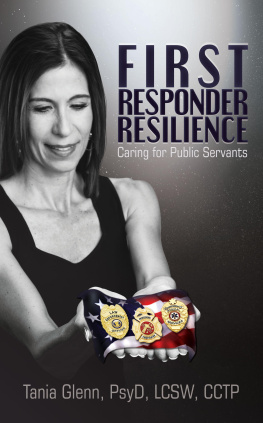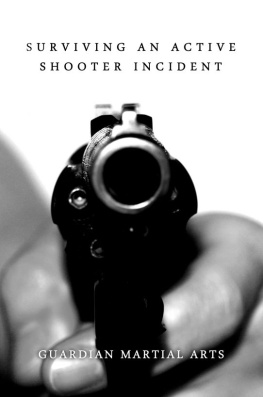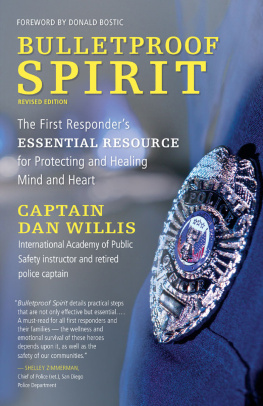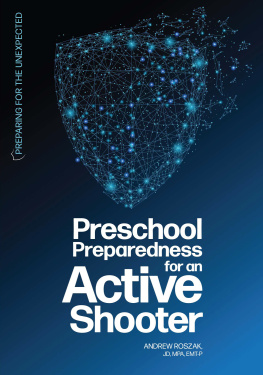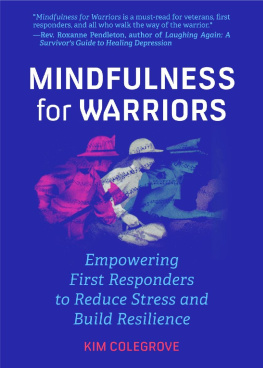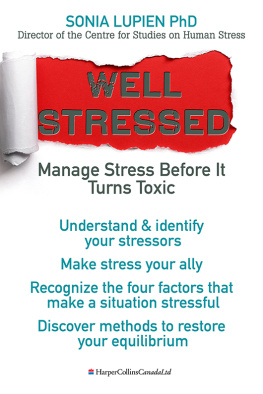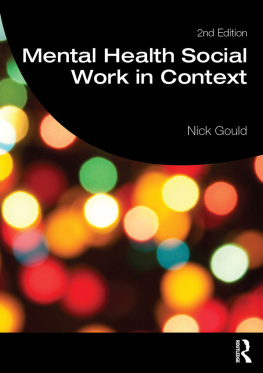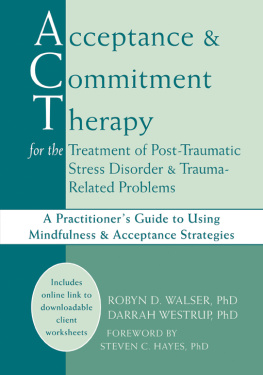Praise for First Responder Resilience:
Caring For Public Servants
The number of people that leave public safety because of addictions to drugs, alcohol, domestic violence issues, or even worse suicide because of the impacts from post-traumatic stress from the things they have seen and the events they have been involved in, is creating a devastating trend in keeping an experienced and happy workforce. Tanias book provides real world steps that she has applied and that have worked in my organization and other organizations to save people that would have left the business, continued with addictive behaviors, or been unable to function because of the terrible effects of PTSD.
This book is not written from someone showing up to the latest movement to talk about how bad traumatic stress is in public safety, but it is written by a true professional that is has been working for decades to keep public safety professionals on the street and functioning in the world that many others dont see, hear, and will never understand.
As a thirty-two-year veteran in public safety, and the Chief Executive responsible for the safety and welfare of the community in which I work, I depend on the employees of the department to respond and take care of each person in a professional, efficient, and positive manner. This only happens when you have employees that are safe and well both physically and mentally.
Tania and the steps in this book will be the start in helping you get a plan to keep yourself, your peers, and your employees well and educated in how to address bad events when they must respond.
We all understand that we cannot change the images, sounds, and odors at the events we are exposed to in the line of duty, but we can change the impacts of those things on our careers by working with true professional like Tania and singing the guidance that comes for her book.
Bill Gardner, CFE, EMT-P
Fire Chief/Emergency Management
Coordinator, City of Leander
Chapter 2
Educate, Educate, Educate!
Im going to change history
Enlighten the world
Teach them how to see through my eyes
Lift Me Up by Five Finger Death Punch, featuring
Rob Halford
The most important first step of appropriate care before trauma occurs is to educate, and keep educating, your most valuable resourceyour people. It is the first and most important step on every syllabus in every academy, class, and initial training on dealing with trauma. You must know how to educate your personnel on the types of stress they will experience in their careers and effective ways to combat it. A stellar presentation is mandatory. One of the best things Ive done in my career has been to develop a strong, poignant, and relevant brief to deliver to my customers. The feedback is consistently positive because the brief flows and makes sense. When a Sergeant Major in the United States Marine Corps declares in a written evaluation that this is the best brief he has seen in twenty years, you know you are on point. When a Lance Corporal from the Marine Corps sends you an email from Iraq stating how everything taught in his pre-deployment brief is exactly right and that he knows how to manage his deployment because he saw the brief, you know youre dead on.
Briefing your staff before, during, and after trauma is imperative. Pre-incident briefs arm recipients with knowledge and understanding of what to expect, that what happens is completely normal and nothing to be ashamed of, and it allows them the opportunity to plan for how they will mitigate the resulting stress. It also reassures them that getting help is good, often necessary, and its what we do.
During a traumatic event, ongoing briefs are great for many reasons. It keeps responders informed when a person of authority connected with the incident, such as a supervisor, can update them. It mitigates rumors and gives clinicians and peer support the ability not only to educate on normal reactions, but also the ability to help affected personnel understand what lies ahead. It allows for the ability to define traumatic grief and to educate personnel on the emotional roller coaster they may experience during trauma. Reminding people to stay hydrated and nourished are all key factors in assuring the path to recovery can begin. It also highlights the fact that support is available and, after a good brief, first responders are much more likely to reach out to available support.
One of the most important aspects of the brief is it builds credibility and trust at a time when first responders are guarded, hurting, even afraid to speak their minds and share what is going on for them. I never, ever, walk up to a brand-new group or agency and expect them to open up. As a matter of fact, I speak first. I teach. I normalize. Then I open things up to discussion if they so choose. Asking a bunch of strong, alpha types to open up and talk first is a definitive setup for failure.
Some of the most remarkable agencies I work with are the ones that have brought me in because a horrific trauma has occurred. Each and every time I walk into a group like this, I am operating at ground zero of credibility. If they have already had poorly conducted debriefings, Im not even at ground zeroIm in the red. I start that brief slowly, and steadily climb my way out of the hole of zero credibility, and I do it by speaking the language of first responders and by using pertinent examples they can connect with. I also apply just the right amount of humor if appropriate. Sometimes humor is appropriate, and sometimes you leave it out.
If you know your audienceif you get good background information going into a brief and you can read them as you go inyou will deliver the right brief. I worked a significantly traumatic helicopter crash and as soon as I saw my audience (about thirty-six hours after the crash), I immediately hid a few of my slides. I could tell by the thousand-yard stares and traumatized facial expressions that they had had very little sleep, their attention spans were tanked, and they could not comprehend much more than a twenty-minute brief. The brief I delivered was to-the-point and exactly what they needed. I know this because, as soon as I was done, the flight crews asked me to develop their recovery plan for the path ahead. They put their faith in me to guide them after a pertinent and well-delivered brief. Know your audience. Listen to your folks. Trust your gut.
At the end of a traumatic incident, a good brief is a fantastic way to tie everything together. First responders have a chance to reflect on how far they have come since day one of the incident, what the sticking points are in their recovery, and how to combat any long-term detrimental effects of trauma.
However, just giving the brief is not enough. You have to mean itreally sell it. You have to love giving it, and your passion needs to come through. With this population, you have to have cool pictures and relevant stories to highlight concepts. If you dont have the passion, dont bother giving a brief. Public servants will walk away and comment this was just another bullshit touchy-feely stress brief. If that happens, your mission has not been accomplished. Worse, you have turned responders off to accepting future briefs and being open to getting help. This is bad, bad, bad.
The Brief
I seriously thought I was losing it, and Id lost all my nerve. These were the words spoken to me recently after a briefing on the fight-or-flight response.
The place to start in a stress/trauma brief is normalizing the stress response by linking it to the fight-or-flight response thats engrained in all of us. Every public safety professional understands this concept, and when the four types of stress are connected to the fight-or-flight response, it normalizes and validates all their reactions. This is how to grab their attention and keep it. We all need the fight-or-flight response to survive. It is the awesome, kick-butt, and amazing human response that allows us to do things we never thought we could. When you set fight or flight at the foundation of stress, it removes the whole touchy feely weakness climate that often exists in stress briefs and that can turn off your audience.
Next page
